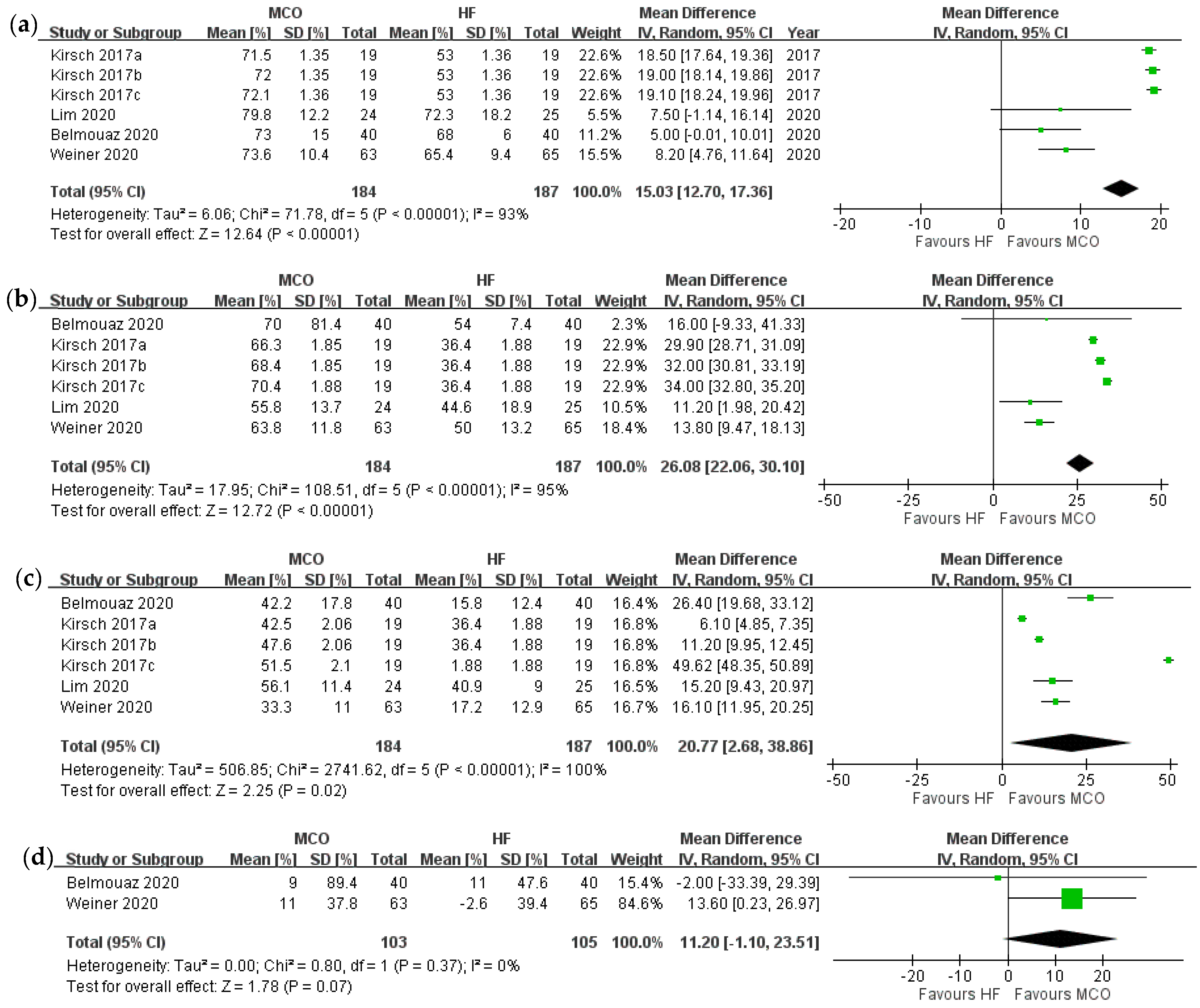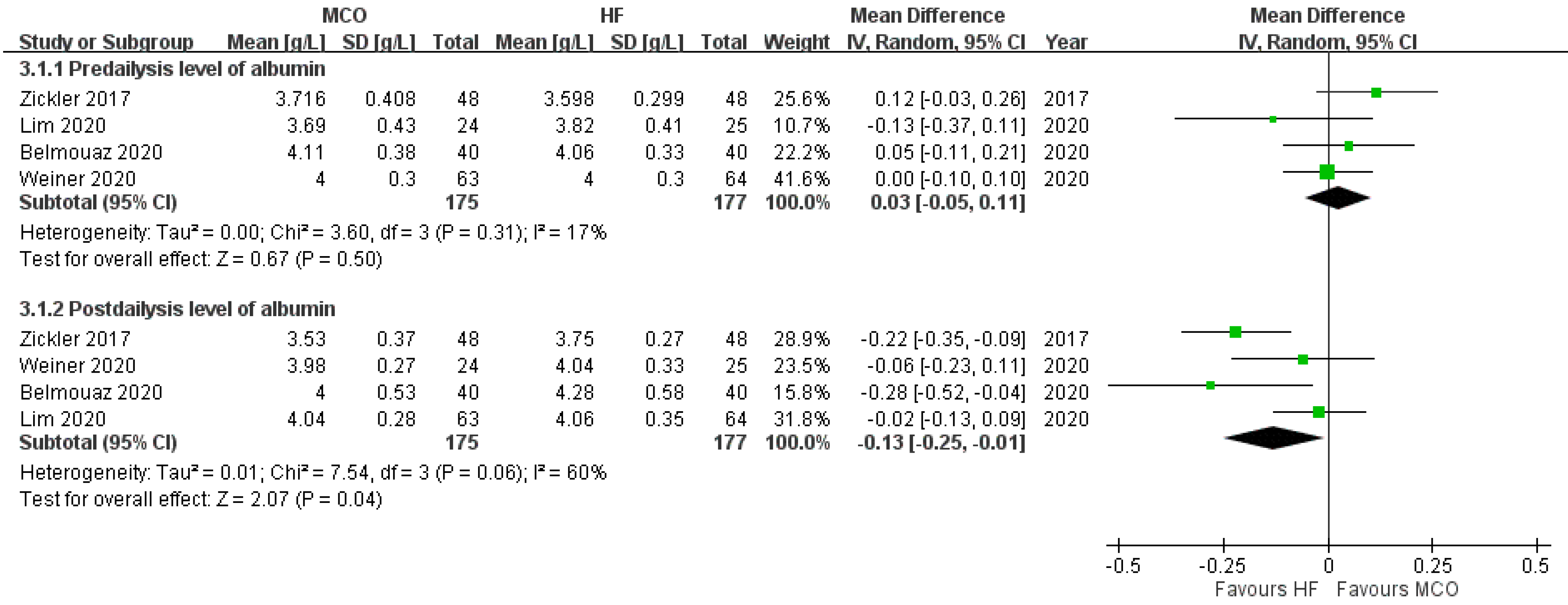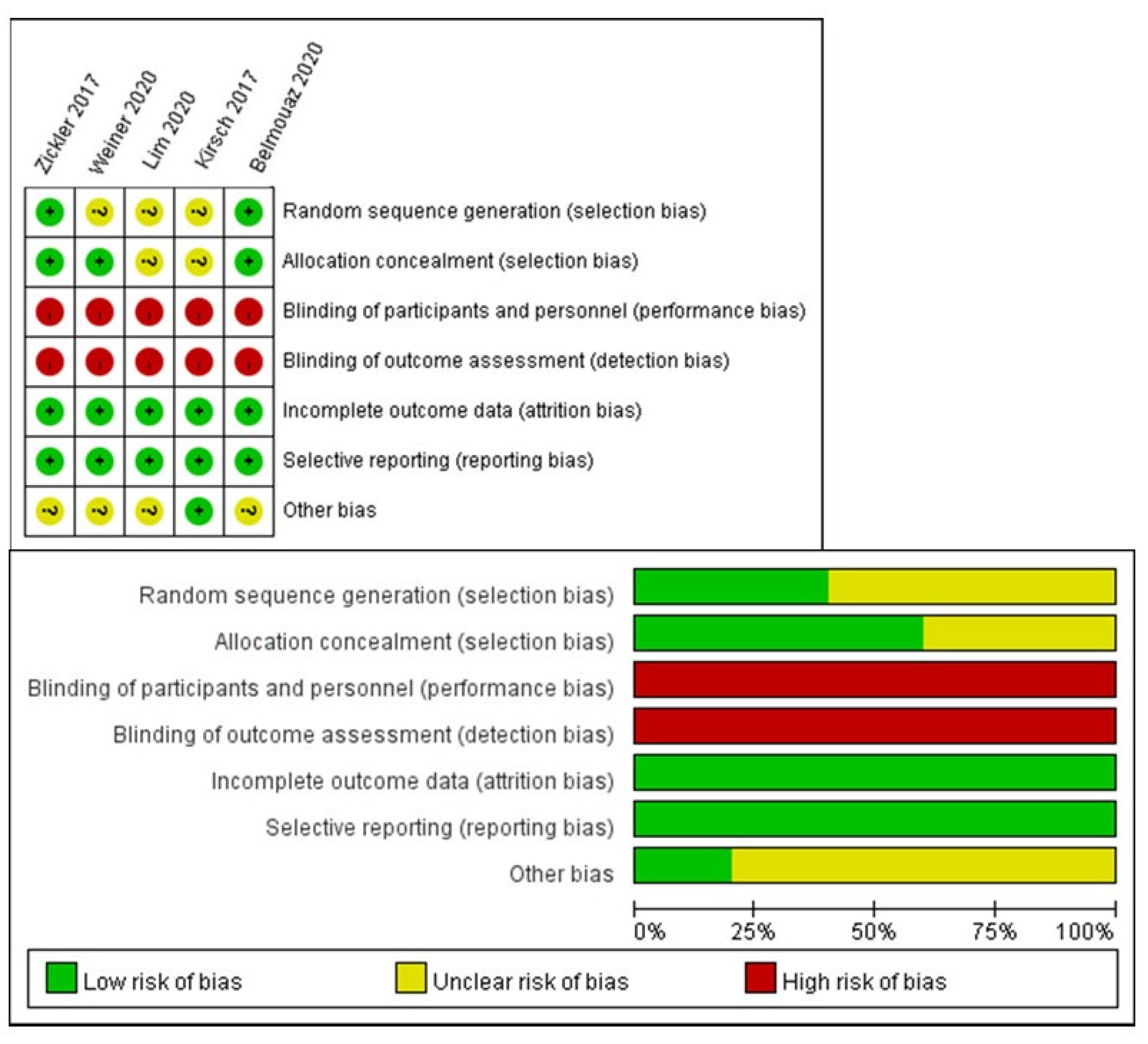Effects of Medium Cut-Off Polyarylethersulfone and Polyvinylpyrrolidone Blend Membrane Dialyzers in Hemodialysis Patients: A Systematic Review and Meta-Analysis of Randomized Controlled Trials
Abstract
1. Introduction
2. Materials and Methods
2.1. Search Strategy
2.2. Eligibility Criteria Intervention Comparison
2.3. Data Extraction
2.4. Risk of Bias Assessment
2.5. Outcomes and Statistical Analysis
2.6. Additional Analysis
3. Results
3.1. Literature Search
3.2. Trial Characteristics
3.3. Primary Outcomes
3.4. Secondary Outcomes
3.5. Publication Bias
3.6. Sensitivity Analysis
4. Discussion
Study Limitations
5. Conclusions
Supplementary Materials
Author Contributions
Funding
Institutional Review Board Statement
Informed Consent Statement
Data Availability Statement
Acknowledgments
Conflicts of Interest
References
- Mitra, S.; Kharbanda, K. Effects of Expanded Hemodialysis Therapy on Clinical Outcomes. Contrib. Nephrol. 2017, 191, 188–199. [Google Scholar] [CrossRef] [PubMed]
- Goldwasser, P.; Mittman, N.; Antignani, A.; Burrell, D.; Michel, M.A.; Collier, J.; Avram, M.M. Predictors of mortality in hemodialysis patients. J. Am. Soc. Nephrol. 1993, 3, 1613–1622. [Google Scholar] [CrossRef] [PubMed]
- Cozzolino, M.; Magagnoli, L.; Ciceri, P.; Conte, F.; Galassi, A. Effects of a medium cut-off (Theranova®) dialyser on haemodialysis patients: A prospective, cross-over study. Clin. Kidney J. 2019, 14, 382–389. [Google Scholar] [CrossRef] [PubMed]
- Kato, S.; Chmielewski, M.; Honda, H.; Pecoits-Filho, R.; Matsuo, S.; Yuzawa, Y.; Tranaeus, A.; Stenvinkel, P.; Lindholm, B. Aspects of immune dysfunction in end-stage renal disease. Clin. J. Am. Soc. Nephrol. 2008, 3, 1526–1533. [Google Scholar] [CrossRef] [PubMed]
- Ciceri, P.; Cozzolino, M. Expanded Haemodialysis as a Current Strategy to Remove Uremic Toxins. Toxins 2021, 13, 380. [Google Scholar] [CrossRef] [PubMed]
- Kuharić, M.; Zibar, L. Screening for Carpal Tunnel Syndrome in Patients on Chronic Hemodialysis. Acta Med. Acad. 2019, 48, 167–176. [Google Scholar] [CrossRef]
- Kopeć, J.; Gadek, A.; Drozdz, M.; Miśkowiec, K.; Dutka, J.; Sydor, A.; Chowaniec, E.; Sułowicz, W. Carpal tunnel syndrome in hemodialysis patients as a dialysis-related amyloidosis manifestation--incidence, risk factors and results of surgical treatment. Med. Sci. Monit. 2011, 17, CR505–CR509. [Google Scholar] [CrossRef] [PubMed][Green Version]
- Florens, N.; Juillard, L. Expanded haemodialysis: News from the field. Nephrol. Dial Transpl. 2018, 33, iii48–iii52. [Google Scholar] [CrossRef] [PubMed]
- Salib, M.; Memon, A.N.; Gowda, A.S.; Rallabhandi, B.; Bidika, E.; Fayyaz, H.; Cancarevic, I. Dialysis Patients With Restless Leg Syndrome: Can We Relieve Their Suffering? Cureus 2020, 12, e10053. [Google Scholar] [CrossRef] [PubMed]
- Ozen, N.; Cinar, F.I.; Askin, D.; Mut, D. Uremic pruritus and associated factors in hemodialysis patients: A multi-center study. Kidney Res. Clin. Pr. 2018, 37, 138–147. [Google Scholar] [CrossRef] [PubMed]
- Kalantar-Zadeh, K.; Block, G.; McAllister, C.J.; Humphreys, M.H.; Kopple, J.D. Appetite and inflammation, nutrition, anemia, and clinical outcome in hemodialysis patients. Am. J. Clin. Nutr. 2004, 80, 299–307. [Google Scholar] [CrossRef] [PubMed]
- Carrero, J.J.; Qureshi, A.R.; Axelsson, J.; Avesani, C.M.; Suliman, M.E.; Kato, S.; Bárány, P.; Snaedal-Jonsdottir, S.; Alvestrand, A.; Heimbürger, O.; et al. Comparison of nutritional and inflammatory markers in dialysis patients with reduced appetite. Am. J. Clin. Nutr. 2007, 85, 695–701. [Google Scholar] [CrossRef] [PubMed]
- Gernone, G.; Partipilo, F.; Detomaso, F.; Pepe, V.; Pietanza, S.; Mitrotti, A. P1084long Term Evaluation of the Expanded Hemodialysis (Hdx) on Dialysis Adequacy, Anemia and Quality of Life. Nephrol. Dial. Transplant. 2020, 35, gfaa142.P1084. [Google Scholar] [CrossRef]
- Hamzi, M.A.; Hassani, K.; Asseraji, M.; El Kabbaj, D. Insomnia in hemodialysis patients: A multicenter study from morocco. Saudi J. Kidney Dis. Transpl. 2017, 28, 1112–1118. [Google Scholar] [CrossRef] [PubMed]
- Kavanagh, D.; Siddiqui, S.; Geddes, C.C. Restless legs syndrome in patients on dialysis. Am. J. Kidney Dis. 2004, 43, 763–771. [Google Scholar] [CrossRef] [PubMed]
- Sakurai, K.; Saito, T.; Hosoya, H.; Kurihara, Y.; Yamauchi, F. Therapeutic effect of high-efficiency online hemodiafiltration for recurrent restless legs syndrome in dialysis patients. J. Artif. Organs 2020, 23, 296–301. [Google Scholar] [CrossRef] [PubMed]
- Aricò, D.; Raggi, A.; Siragusa, M.; Zucconi, M.; Ferri, R. Restless legs syndrome as the presenting symptom of multiple myeloma. J. Clin. Sleep Med. 2013, 9, 383–385. [Google Scholar] [CrossRef] [PubMed][Green Version]
- Donati, G.; Moretti, M.I.; Baraldi, O.; Spazzoli, A.; Capelli, I.; Comai, G.; Marchetti, A.; Sarma, M.; Mancini, R.; La Manna, G. Removal of free light chains in hemodialysis patients without multiple myeloma: A crossover comparison of three different dialyzers. BMC Nephrol. 2016, 17, 193. [Google Scholar] [CrossRef]
- Kamimura, M.A.; Draibe, S.A.; Dalboni, M.A.; Cendoroglo, M.; Avesani, C.M.; Manfredi, S.R.; Canziani, M.E.F.; Cuppari, L. Serum and cellular interleukin-6 in haemodialysis patients: Relationship with energy expenditure. Nephrol. Dial. Transplant. 2007, 22, 839–844. [Google Scholar] [CrossRef]
- Barreto, D.V.; Barreto, F.C.; Liabeuf, S.; Temmar, M.; Lemke, H.D.; Tribouilloy, C.; Choukroun, G.; Vanholder, R.; Massy, Z.A. Plasma interleukin-6 is independently associated with mortality in both hemodialysis and pre-dialysis patients with chronic kidney disease. Kidney Int. 2010, 77, 550–556. [Google Scholar] [CrossRef]
- Lichtenberg, S.; Korzets, A.; Zingerman, B.; Green, H.; Erman, A.; Gafter, U.; Rozen-Zvi, B. An intradialytic increase in serum interleukin-6 levels is associated with an increased mortality in hemodialysis patients. Int. J. Artif. Organs 2015, 38, 237–243. [Google Scholar] [CrossRef] [PubMed]
- Memoli, B.; Libetta, C.; Rampino, T.; Dal Canton, A.; Conte, G.; Scala, G.; Ruocco, M.R.; Andreucci, V.E. Hemodialysis related induction of interleukin-6 production by peripheral blood mononuclear cells. Kidney Int. 1992, 42, 320–326. [Google Scholar] [CrossRef][Green Version]
- Girndt, M.; Sester, U.; Kaul, H.; Köhler, H. Production of proinflammatory and regulatory monokines in hemodialysis patients shown at a single-cell level. J. Am. Soc. Nephrol. 1998, 9, 1689–1696. [Google Scholar] [CrossRef] [PubMed]
- Drüeke, T.B.; Massy, Z.A. Beta2-microglobulin. Semin. Dial. 2009, 22, 378–380. [Google Scholar] [CrossRef]
- Lindgren, A.; Fjellstedt, E.; Christensson, A. Comparison of Hemodialysis Using a Medium Cutoff Dialyzer versus Hemodiafiltration: A Controlled Cross-Over Study. Int. J. Nephrol. Renov. Dis. 2020, 13, 273–280. [Google Scholar] [CrossRef]
- Maduell, F.; Sánchez-Canel, J.J.; Blasco, J.A.; Navarro, V.; Ríus, A.; Torregrosa, E.; Pin, M.T.; Cruz, C.; Ferrero, J.A. Middle molecules removal. Beyond beta2-microglobulin. Nefrologia 2006, 26, 469–475. [Google Scholar]
- Brunati, C.C.M.; Gervasi, F.; Cabibbe, M.; Ravera, F.; Menegotto, A.; Querques, M.; Colussi, G. Single Session and Weekly Beta 2-Microglobulin Removal with Different Dialytic Procedures: Comparison between High-Flux Standard Bicarbonate Hemodialysis, Post-Dilution Hemodiafiltration, Short Frequent Hemodialysis with NxStage Technology and Automated Peritoneal Dialysis. Blood Purif. 2019, 48, 86–96. [Google Scholar] [CrossRef] [PubMed]
- Boschetti-de-Fierro, A.; Voigt, M.; Storr, M.; Krause, B. MCO Membranes: Enhanced Selectivity in High-Flux Class. Sci. Rep. 2015, 5, 18448. [Google Scholar] [CrossRef]
- Hulko, M.; Gekeler, A.; Koch, I.; Dietrich, V.; Krause, B. Fp516dialysis Membrane Pore Size Does not Determine Lps Retention. Nephrol. Dial. Transplant. 2015, 30, iii244. [Google Scholar] [CrossRef][Green Version]
- Ronco, C.; Marchionna, N.; Brendolan, A.; Neri, M.; Lorenzin, A.; Martínez Rueda, A.J. Expanded haemodialysis: From operational mechanism to clinical results. Nephrol. Dial. Transpl. 2018, 33, iii41. [Google Scholar] [CrossRef] [PubMed]
- Alarcon, J.C.; Bunch, A.; Ardila, F.; Zuñiga, E.; Vesga, J.I.; Rivera, A.; Sánchez, R.; Sanabria, R.M. Impact of Medium Cut-Off Dialyzers on Patient-Reported Outcomes: COREXH Registry. Blood Purif. 2021, 50, 110–118. [Google Scholar] [CrossRef]
- Belmouaz, M.; Bauwens, M.; Hauet, T.; Bossard, V.; Jamet, P.; Joly, F.; Chikhi, E.; Joffrion, S.; Gand, E.; Bridoux, F. Comparison of the removal of uraemic toxins with medium cut-off and high-flux dialysers: A randomized clinical trial. Nephrol. Dial. Transpl. 2020, 35, 328–335. [Google Scholar] [CrossRef]
- Weiner, D.E.; Falzon, L.; Skoufos, L.; Bernardo, A.; Beck, W.; Xiao, M.; Tran, H. Efficacy and Safety of Expanded Hemodialysis with the Theranova 400 Dialyzer: A Randomized Controlled Trial. Clin. J. Am. Soc. Nephrol. 2020, 15, 1310–1319. [Google Scholar] [CrossRef] [PubMed]
- Li, P.J.; Jin, T.; Luo, D.H.; Shen, T.; Mai, D.M.; Hu, W.H.; Mo, H.Y. Medium Cut-Off (MCO) Membranes Reduce Inflammation in Chronic Dialysis Patients—A Randomized Controlled Clinical Trial. PLoS ONE 2017, 12, e0141332. [Google Scholar] [CrossRef]
- Kirsch, A.H.; Lyko, R.; Nilsson, L.G.; Beck, W.; Amdahl, M.; Lechner, P.; Schneider, A.; Wanner, C.; Rosenkranz, A.R.; Krieter, D.H. Performance of hemodialysis with novel medium cut-off dialyzers. Nephrol. Dial. Transpl. 2017, 32, 165–172. [Google Scholar] [CrossRef] [PubMed]
- Lim, J.-H.; Park, Y.; Yook, J.-M.; Choi, S.-Y.; Jung, H.-Y.; Choi, J.-Y.; Park, S.-H.; Kim, C.-D.; Kim, Y.-L.; Cho, J.-H. Randomized controlled trial of medium cut-off versus high-flux dialyzers on quality of life outcomes in maintenance hemodialysis patients. Sci. Rep. 2020, 10, 7780. [Google Scholar] [CrossRef] [PubMed]
- Bailar, J.C., 3rd. The promise and problems of meta-analysis. N. Engl. J. Med. 1997, 337, 559–561. [Google Scholar] [CrossRef] [PubMed]
- Murray, G.D. Meta-analysis. Br. J. Surg. 1990, 77, 243–244. [Google Scholar] [CrossRef]
- Zickler, D.; Schindler, R.; Willy, K.; Martus, P.; Pawlak, M.; Storr, M.; Hulko, M.; Boehler, T.; Glomb, M.A.; Liehr, K.; et al. Medium Cut-Off (MCO) Membranes Reduce Inflammation in Chronic Dialysis Patients-A Randomized Controlled Clinical Trial. PLoS ONE 2017, 12, e0169024. [Google Scholar] [CrossRef] [PubMed]
- Esposito, P.; Cipriani, L.; Verzola, D.; Grignano, M.A.; De Amici, M.; Testa, G.; Grosjean, F.; Russo, E.; Garibotto, G.; Rampino, T.; et al. Effects of Different Dialysis Strategies on Inflammatory Cytokine Profile in Maintenance Hemodialysis Patients with COVID-19: A Randomized Trial. J. Clin. Med. 2021, 10, 1383. [Google Scholar] [CrossRef]
- Kim, T.H.; Kim, S.-H.; Kim, T.Y.; Park, H.Y.; Jung, K.S.; Lee, M.H.; Jhee, J.H.; Lee, J.E.; Choi, H.Y.; Park, H.C. Removal of large middle molecules via haemodialysis with medium cut-off membranes at lower blood flow rates: An observational prospective study. BMC Nephrol. 2019, 21, 2. [Google Scholar] [CrossRef] [PubMed]
- Maduell, F.; Rodas, L.; Broseta, J.J.; Gómez, M.; Montagud-Marrahi, E.; Guillén, E.; Hermida, E.; Xipell, M.; Arias-Guillén, M.; Vera, M.; et al. Evaluation of the influence of the surface membrane and blood flow in medium «cut-off» (MCO) dialyzers. Nefrología 2019, 39, 623–628. [Google Scholar] [CrossRef] [PubMed]
- Merabet, E.; Dagogo-Jack, S.; Coyne, D.W.; Klein, S.; Santiago, J.V.; Hmiel, S.P.; Landt, M. Increased Plasma Leptin Concentration in End-Stage Renal Disease1. J. Clin. Endocrinol. Metab. 1997, 82, 847–850. [Google Scholar] [CrossRef] [PubMed]
- Ronco, C. The Rise of Expanded Hemodialysis. Blood Purif. 2017, 44, I–VIII. [Google Scholar] [CrossRef]




| First Author, Year | Country | MCO Membrane Dialyzer | Controlled Group | Method | Experimental Period | Patient Number (Male %) | Primary End-Point | Secondary End-Point |
|---|---|---|---|---|---|---|---|---|
| Kirsch 2017 | Austria | Theranova®400 | FX CorDiax 80 FX CorDiax 800 (HDF) | Open-label, cross-over RCT | Once (4–5 h) | 19 (72.0%) | kFLC overall clearance | Overall clearances and pre-to-post-reduction ratios of middle and small molecules |
| Zickler 2018 | Germany | MCO-Ci 400® | Revaclear 400 | Open-label, cross-over RCT | 4 weeks of MCO + (4 weeks wash-out) + 4 weeks of high-flux HD | 48 (72.9%) | The gene expression of TNF-α and IL-6 in PBMCs | Specified inflammatory mediators, cytokines |
| Belmouaz 2020 | France | Theranova®500 | Elisio 21H | Open-label, cross-over RCT | 3 months of MCO + 3 months of high-flux HD | 40 (70.0%) | Myoglobin RR | Other middle-weight toxins |
| Lim 2020 | Korea | Theranova®400 | FX CorDiax 80 or 60 | Open-label, concurrent RCT | 12 weeks | MCO: 24 (75%) HF: 25 (60%) | Laboratory data, UF volume, and dialysis adequacy | Middle molecule removal |
| Weiner 2020 | The United States | Theranova®400 | Elisio-17H | Open-label, concurrent RCT | 24 weeks | MCO: 86 (63%) HF: 86 (59%) | Free light chains RR | Complement factor D, free k light chains, TNF-alpha, b2-microglobuli, IL-6 |
Publisher’s Note: MDPI stays neutral with regard to jurisdictional claims in published maps and institutional affiliations. |
© 2022 by the authors. Licensee MDPI, Basel, Switzerland. This article is an open access article distributed under the terms and conditions of the Creative Commons Attribution (CC BY) license (https://creativecommons.org/licenses/by/4.0/).
Share and Cite
Hung, Y.-H.; Lai, T.-S.; Belmouaz, M.; Tu, Y.-C.; Lai, C.-F.; Lin, S.-L.; Chen, Y.-M. Effects of Medium Cut-Off Polyarylethersulfone and Polyvinylpyrrolidone Blend Membrane Dialyzers in Hemodialysis Patients: A Systematic Review and Meta-Analysis of Randomized Controlled Trials. Membranes 2022, 12, 443. https://doi.org/10.3390/membranes12050443
Hung Y-H, Lai T-S, Belmouaz M, Tu Y-C, Lai C-F, Lin S-L, Chen Y-M. Effects of Medium Cut-Off Polyarylethersulfone and Polyvinylpyrrolidone Blend Membrane Dialyzers in Hemodialysis Patients: A Systematic Review and Meta-Analysis of Randomized Controlled Trials. Membranes. 2022; 12(5):443. https://doi.org/10.3390/membranes12050443
Chicago/Turabian StyleHung, Yu-Hui, Tai-Shuan Lai, Mohamed Belmouaz, Ya-Chun Tu, Chun-Fu Lai, Shuei-Liong Lin, and Yung-Ming Chen. 2022. "Effects of Medium Cut-Off Polyarylethersulfone and Polyvinylpyrrolidone Blend Membrane Dialyzers in Hemodialysis Patients: A Systematic Review and Meta-Analysis of Randomized Controlled Trials" Membranes 12, no. 5: 443. https://doi.org/10.3390/membranes12050443
APA StyleHung, Y.-H., Lai, T.-S., Belmouaz, M., Tu, Y.-C., Lai, C.-F., Lin, S.-L., & Chen, Y.-M. (2022). Effects of Medium Cut-Off Polyarylethersulfone and Polyvinylpyrrolidone Blend Membrane Dialyzers in Hemodialysis Patients: A Systematic Review and Meta-Analysis of Randomized Controlled Trials. Membranes, 12(5), 443. https://doi.org/10.3390/membranes12050443






